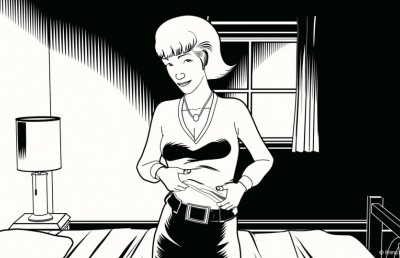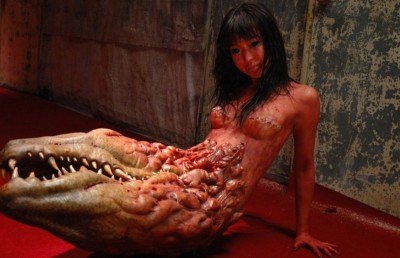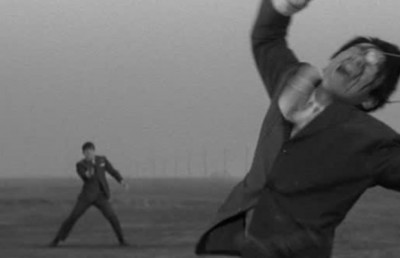Double Dose of Thai Horror
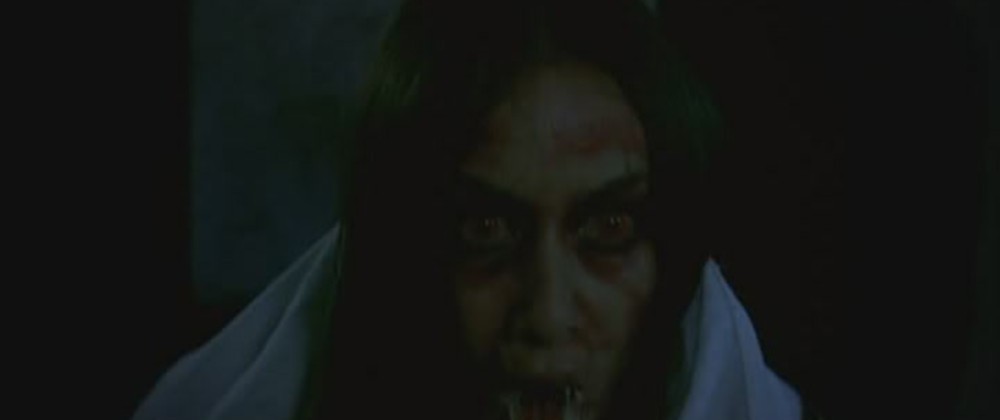
Alone (Banjong Pisanthanakun, Parkpoom Wongpoom, Thailand, 2007)
4bia (Banjong Pisanthanakun, Parkpoom Wongpoom, Youngyooth Thongkonthun, Paween Purikitpanya, Thailand, 2008)
While the Asian horror film may feel in recent years like it is in need of rejuvenation, in terms of sheer numbers the genre is alive and well, with new films from a vast number of Asian countries being produced every year; and, when successful, an American remake not too far behind. One country that has helped increase the numbers recently is Thailand, with such films as The Art of the Devil (now up to three films, directed by the group Ronin), Rahtree: Flower of the Night and Rahtree Returns (dir. Yuthlert Sippapak) and Spirit of the Victim (Monthon Arayangkoon). Two young directors stand above the pack, Banjong Pisanthanakun and Parkpoom Wongpoom, who have added a necessary shot in the arm to Asian horror with their two recently co-directed films Shutter (2004, remade in the US in 2007, directed by Jessica Joy Wise) and Alone (2007). Their names also appear together but as separate directors for the first time on the recent omnibus/portmanteau film 4bia (2008), where they are joined by directors Youngyooth Thongkonthun and Paween Purikitpanya for the four story feature film. Alone and 4bia played at this year’s Fantasia International Film Festival and Banjong Pisanthanakun, Parkpoom Wongpoom, Paween Purikitpanya, and Youngyooth Thongkonthun were invited guests.
Alone begins in Korea, where a young couple, Pim (Marsha Wattanapanich) and Vee (Vittaya Wasukraipaisan), receive news that Pim’s mother has suffered a stroke, which obliges them to return to their homeland of Thailand. While living in her ancestral home we learn that Pim had a conjoined twin sister named Ploy who died at the age of 15. When Pim begins seeing ghostly images of her dead sister her husband Vee begins to doubt her mental health and convinces Pim to see his longtime psychiatrist friend. Are the ghostly images real or a product of Pim’s delusional, guilt-inflected mind? And what could she possibly be guilty about? The film continually flashes back to when Pim and Ploy were conjoined twins, and we witness the growing animosity between them and Ploy’s jealousy over young Vee’s attraction to Pim (the nicer sister). How did Ploy die? Indeed, is it Ploy that died or did Ploy kill Pim and assume her identity to win Vee’s affections? A series of murders bring the past and present together leading to the film’s audacious climax. One of the film’s most interesting elements is its thematic use of color, with each setting and time period shot in a different color scheme. For example, the way drab, earthy colors represent a sense of melancholia and sadness in the present.
4bia is a conscious attempt to reinvigorate Asian horror, with a blend of irony, self-parody, and straight ahead horror. The opening story “Happiness” is directed by the slightly older Youngyooth Thongkonthun, who comes to the film having established himself as a comedy director with the previous comic hits The Iron Ladies (2000) and The Iron Ladies 2 (2001), both of which feature gays, transvestites and transsexuals, Maid (2004), and Metrosexual (2006). “Happiness” is about a girl with a broken leg holed up in her high-rise apartment who begins a text messaging relationship with a stranger. What makes the claustrophobic tale innovative is the absence of dialogue and the non-linear structure. The second story, directed by Paween Purikitpanya, “Tit for Tat,” is a more conventional revenge story about a picked upon school boy who metes out revenge using black magic. The story’s extreme levels of violence and use of black magic makes it a distant cousin of the popular The Art of the Devil films. Up next is the story directed by Banjong Pisanthanakun, “In the Middle,” which offers a comic change of pace and reflexive look at Asian horror. Four young male friends go camping Deliverance-style and spend the evening spinning urban yarns and trying to scare each other. While lying next to each other in their tent (captured in an overhead angle) one of them promises that if he ever dies he will return to haunt the person who is in the middle. They go rafting the next morning, but the current capsizes their boat. One of their friends –the promiser– goes missing but returns later that night… ..but is he alive or dead? The final story, directed by Parkpoom Wongpoom, is the scariest and most classical of the four, dealing with a female flight attendant, Pim (Laila Boonyasak), who is called to work at the request of a princess flying on her personal charter plane. The princess, Sophia, has requested Pim so as to enact retribution over Pim’s affair with her husband. Sophia’s plan goes south, however, when she dies from a food allergy served to her by Pim. The bulk of the story consists of a nervous Pim sharing the flight back alone with the bandaged corpse of the princess. Turbulence, Pim’s paranoia, and, possibly Sophia’s vengeful spirit, makes for a harrowing finale. Offscreen had the pleasure of interviewing Youngyooth Thongkonthun (who also produced Alone), Banjong Pisanthanakun, Parkpoom Wongpoom, and Paween Purikitpanya.
Haleema Mini served as translator for this interview. A big thanks to her!
Offscreen: How do you share the directing on set? Does one of you deal more with the acting and the other with the visuals?
Banjong Pisanthanakun and Parkpoom Wongpoom: We always discuss everything before we start shooting and do everything together as a team. Whether it is acting, location scouting, sets, etc., we talk to each other before we talk to anyone else.
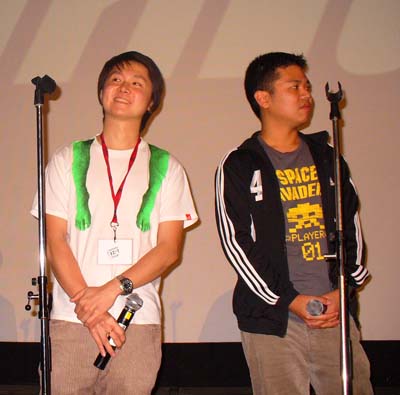
Offscreen: How did you get into film? Where did you study? Was Youngyooth your teacher and what was is your relationship with him?
Youngyooth Thongkonthun: Banjong and Parkpoom have the same alma mater. Bangjong worked with Parkpoom at a production house called Phenomena films as assistant directors for commercial productions. And then they won a spot to direct a feature film. And then Phenomena came to talk with me at my production company GBH. That was the start of Shutter and after that they decided to do Alone together and continued to work together on 4bia.
Banjong Pisanthanakun: We went to the same university at the same time.
Offscreen: So there is a film department at the University?
Youngyooth: Yes there is one just like here [Montreal’s Concordia University], in the faculty of Communication Arts.
Offscreen: Are they open to the genre films at the University, because at our University where we teach film is in the fine art faculty and students are less likely to produce genre films. They are more likely to make art films, personal films, documentary films.
Youngyooth: They can make any kind of film they want at the University.
Offscreen: There have been a few recent Asian omnibus horror films, like Three Extremes, Three, Scary True Stories, but not many. The first Three (2002) even had a Thai director, Nonzee Nimitbur, who did Nang Nak (1999), that played here in 1999. A very good film. How did the idea of doing a film with four multiple stories and directors come about?
Youngyooth: There have been several Asian horror films with many stories but they have not been very successful because it often is a mixture of different Asian countries and they usually do it separately and then put the film together; whereas we worked together so that each story complemented each other. And we also were sure to make each story work as a short story.
Offscreen: After the screening the other night you talked about the editing of 4bia and how you experimented with the order of the stories. I think the way it is now works very well because the first and last story both deal with a woman in an isolated space dealing with a ghost, so they really refer to each other. And it reminded me of a quote by one of my [Totaro] favorite directors Mario Bava, who once said: “All I need to make a horror film is a camera, some lights, a room, and a woman.” And that basically describes the first and the fourth story. Can you talk about the order of the stories that you had considered before finalizing on this? What was the order that you experimented with before settling in this one?
Youngyooth: We came up with the four stories and then put them in different sequences and we had focus groups with the different edits and it seemed that in every case the last story was the one that people liked the least. We figured that maybe by the last story people were becoming tired or less interested! But then we decided on this particular sequence and it received the best reception from the focus groups. And this was the sequence that we had envisioned from the start anyway.
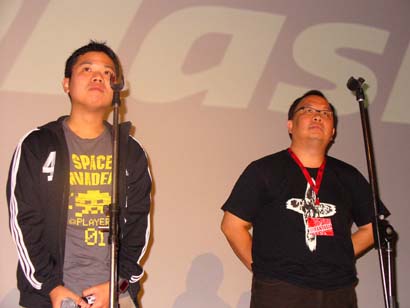
Offscreen: I just want to ask about another thing that I found very interesting about 4bia that made it different from other Asian horror and ghost story films. In the majority of Asian horror films and ghost stories the ghosts are female and that is bound up in tradition, culture and folklore, and has now become a cinematic convention. In 4bia three of the four ghosts are male, so I was wondering if that was just a coincidence that was arrived at individually or were you conscious of changing that up, because as a viewer it feels a little strange to see a male ghost. I think we are conditioned to it being a woman, preferably with long dark hair. In 90% of Asian ghost films the ghost is female. This is the case also in your two feature films Shutter and Alone. But not in 4Bia, where three of the four stories feature male ghosts. Was this a conscious choice to make it different, or just a coincidence?
Banjong Pisanthanakun: My section is called “In the middle” and yes I did want to turn the tradition backward and make fun of the traditional ghost story.
Paween Purikitpanya: My section called “Tit-for-tat” (2nd) is about a child who comes back for revenge and it just felt like it suited a boy more because boys will often pick on the other boys.
Offscreen: I have a general question on Alone about the Siamese twins because when I [Peter Rist] was a child in England I remember this famous story of Chang and Eng Bunker and so I wondered how important the whole history of that story was in Thailand? And the fact that they are called Chang and Eng does this mean they were Chinese from Thailand? Were the original Siamese twins ethnically Chinese?
Youngyooth: Yes it is a pretty big part of our culture and there is even a big monument to them in their home town. There are stories and plays about them and even a documentary about them so it is a big part of their culture, and they are half Chinese.
Offscreen: As a follow-up question have there been other Thai films about the Siamese twins?
Youngyooth: I think there have been films made on them from other countries but not from Thailand.
Offscreen: Have you seen other films dealing with good/bad twins, such as The Dark Mirror, Mirror, Mirror, Sisters, or A Tale of Two Sisters?
Banjong Pisanthanakun and Parkpoom Wongpoom: We did most of our research through books rather than watching movies.
Offscreen: I want to ask a question relating to the very controlled use of color in Alone. For example in the Thai section I don’t think there were any lively colors, no reds, yellows, dark blues. It was all somber colors, brown, tan, gray and black. My memory of the Korea section is that it had more natural colors and then the flashbacks were also muted but with more contrast. For example even in the beach scene in Alone the sand was greenish not brown.
Banjong Pisanthanakun and Parkpoom Wongpoom: Yes we did extensive work on the color. For each part, Korea, Bangkok, the past, the present we did a lot of color testing with the film. For the period sections we used something called a chocolate filter.
Youngyooth: We did tests before we even started. For example we would bring a piece of clothing and place it next to a wall and take a picture and then we would go through the bleach bypass process to see how the colors would come out. So it was all planned out.
Offscreen: I [Rist] have always wanted to ask this question because to me there is a certain look to films from Thailand that I don’t see in any other films which is very interesting. I even saw it in Alexander (2004, Oliver Stone). I am wondering whether there is some special film stock that you use in Thailand, but maybe it is the chocolate filter that you use. I don’t know what it is that gives the films their distinct look.

Banjong Pisanthanakun and Parkpoom Wongpoom: I think film stock is the same as everywhere else, so it might have to do with the temperature and quality of light, but in Alone there is a lot of process work done from production to post-production work which was used to mute the colors. We also used a process called “bleach bypass.”
Offscreen: I find it hard to explain but I think the film looks fantastic and has a very consistent look. There is something about the way it is dark even during the day scenes, and the subtle lighting you have with colors that are muted but still strong, like the brown is very strong so when you see red it is very strong also. I find it fascinating because right from the first Thai film I saw I was struck by how this was a completely different look from Hong Kong film, Chinese film, and Japanese film. And I see it in this film also and it seems to work especially well with horror and ghost stories because of this faint light.
Offscreen: The other thing about the visual look which is also important is the use of reflections and seeing extra images, which goes back to Shutter, a film with a photographer as its main protagonist. Can you talk about how you incorporate the use of reflections, doubles, and the use of photographs at the script level as part of the visual element, which is all very important?
Youngyooth: Well, all we can say is that, yes, all of these elements, these visual elements, the reflections, etc., are written into the script.
Offscreen: I am not sure if this is related but you have worked with the same DP (director of photography), Niramon Ross, in both films. How did you meet him?
Youngyooth: It is a she!
Offscreen: Oh that is very interesting.
Youngyooth: She is a tiny woman but a very good cinematographer who lives in NY and has worked on many Mexican films.
Offscreen: Is she Thai?
Youngyooth: Yes. Married to an American, hence the surname Ross.
Offscreen: Did she work on 4bia as well?
Paween Purikitpanya: Yes, the third and fourth parts.
Offscreen: And the other two stories?
Youngyooth: Different DP because we shot those in HD.
Offscreen: So the first and second were shot on HD and the last two on film?
Youngyooth:Yes.
Offscreen: Well that makes sense since the second story is the one that has the most visual effects to it, with the most CGI.
Offscreen: The performance by Masha Wattanapanich in the dual role in Alone is outstanding. Was that her first film?
Youngyooth: No she has made many films especially when she was younger. Then she stopped her acting career for about 10 years to pursue a career in singing. And then she worked on television and this was her first feature film after her television work.
Offscreen: How did you cast the Siamese twins?
Banjong Pisanthanakun and Parkpoom Wongpoom: It was difficult to cast them. We did it through the internet, newspapers and radio but we still could not find the actresses and then we looked at pictures of actresses who had come to do some commercials and that is how we found them.
Offscreen: Is there any meaning to the names of the Siamese twins, Ploy and Pim, because I know that Pen-Ek Ratanaruang made a film called Ploy (2007), but because ploy also means something in English. In English the word means to plot something, or is a way of doing something deviously, like killing someone, which is what the Ploy/Pim character does. But Pim does not mean anything except maybe a cocktail.
Youngyooth: No. It is more like a generic name. And actually the actress Masha’s old name is Pim.
Offscreen: If we can go back to 4bia I have a question about the fourth story, “Last Fright.” One way that you could read it is that there is no real ghost but that the lead character is imagining it, because she is the only one who physically sees the ghost. Every time one of the external characters enters the cabin the ghost is wrapped up in her chair. And the fact that the lead character is found dead with her neck broken might have been caused by the plane turbulence, where she might have been thrown. So you can read it both ways, that there is a real ghost or that she is imagining it as a product of her guilt for having slept with the princess’ husband. And again that latter reading would be unusual for an Asian horror film.
Banjong Pisanthanakun and Parkpoom Wongpoom: Yes that is what we had in mind that the audience would have to figure it out for themselves.
Offscreen: Because there is a bit of that ambiguity in Alone as well at least for a while, because you have a psychiatrist and the rational world and the supernatural, but then at some point the ghost becomes very real.
Offscreen: Since we could not interview you before with Shutter, there was an interesting statement made after the film today about the story of a woman who imagined having a baby on her shoulder and had an abortion. Can you tell us a little bit about that story and how it might have influenced Shutter?
Banjong Pisanthanakun and Parkpoom Wongpoom: Well, the story about the baby on the shoulder is like an urban legend that exists in many other countries, including Thailand. When you have drinks together and trade horror stories that is one that comes up quite a bit. In fact Shutter did not start from that image it just started as a story and it turned out that we could put that in at the end, because it is a very good image to use.
Offscreen: By now the Asian horror cinema has set up a staple of devices that occur again and again: the elevated sound, the quick edit, the use of technology as a medium, the natural world vs. supernatural world, the long black haired vengeful female ghost, the floating ghost, the use of technological media, such as the photograph, cell phone, telephone, television, computer, etc. as a transporter of the traditional evil into modernity, etc. I am just curious as to how you feel about the state of the genre now. Do you feel it needs to move on, or that there has to be something new happening? Would you like to continue making horror films?
Banjong Pisanthanakun and Parkpoom Wongpoom: Yes we have hit a bit of an oversaturated point now with horror, but when we get a good idea we still want to do it. We do see a lot of horror movies from Asia and other countries and a lot of them are getting pretty stale, but once in a while you get something that is very good. So we have reached a point where we are little bored with it but we are still hopeful that we can find an interesting story out of the genre. We also find it a challenge to try to find a story that people will get excited about again.
Offscreen: Is it right in saying that the ghost story is a big part of Thai culture, rather than the more Western kind of monster? I know in Hong Kong it is like that when we think of horror in the West it is very different. So maybe you can talk a little bit about the cultural tradition of the ghost in Thailand.
Banjong Pisanthanakun and Parkpoom Wongpoom: Yes zombies and those type of monster do not frighten Thai people. It is mostly things that are more spiritual that feel scarier to us.
Offscreen: Does that come from philosophy, Buddhism, or animism, or religion?
Banjong Pisanthanakun and Parkpoom Wongpoom: Yes definitely it has something to do with Buddhism and animism. Even if you think of a big tree we might think there is a spiritual or guardian angel inside it. And in a more general sense there are more Thai people that believe in ghosts than here.
Offscreen: Yes I have read certain reviews of films like Shutter which make a claim, and sometimes it comes across as a negative one regarding the narrative believability, that the characters accept the ghost right away, but from your perspective it is very natural to assume the ghost is real. The character does not have to go through a whole set of facts and evidence before they except the ghost is real.
Youngyooth: That is something which I find interesting because each country has its own idea of what a ghost is. In the West the ghost always wears white and floats.
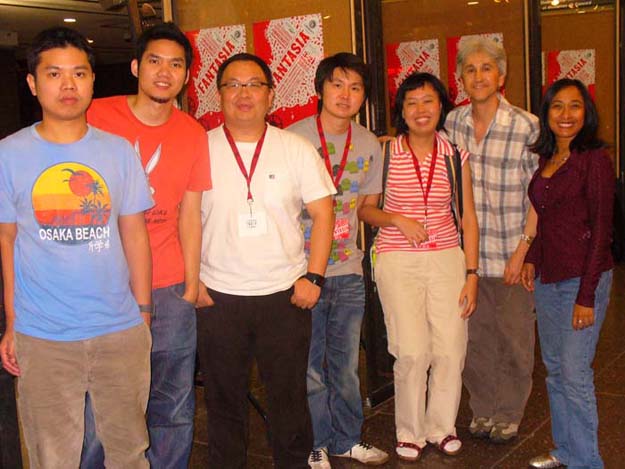
Once again, translation by Haleema Mini. A special thanks to Mi-jeong Lee for helping to co-ordinate this interview.




